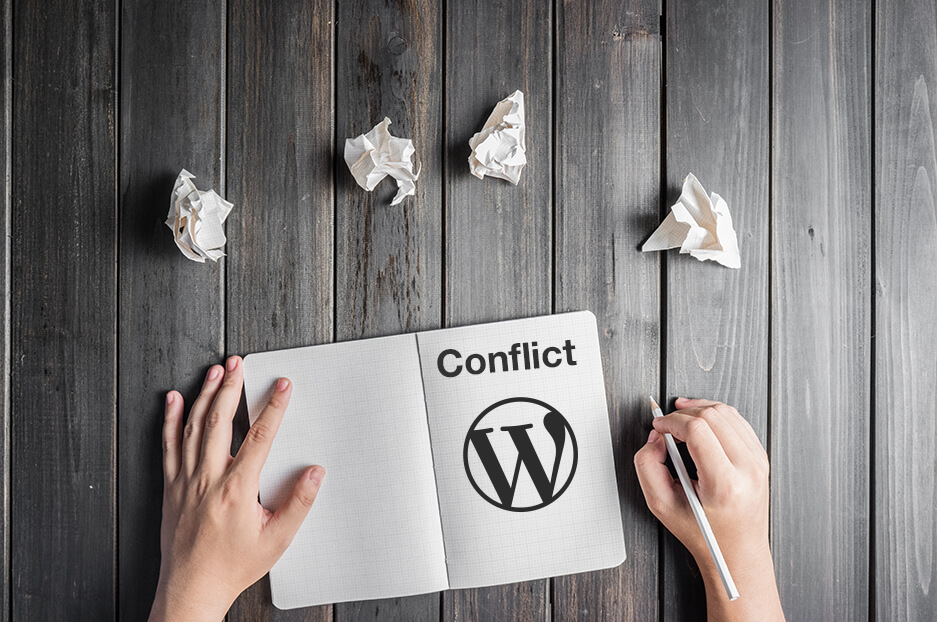Add-on plugins are meant to extend your WordPress website’s functionality with no limits. WordPress offers 50,000+ plugins to choose from. Each of them performs an important task of its own.
In this abundance, there is a flip side — possible WordPress plugin conflicts. Let’s discuss how you can discover, fix, and avoid them in the future. Hopefully, this article, just like the one on fixing WordPress theme issues, will help make your website work more smoothly.
What are WordPress plugin conflicts?
A WordPress plugin conflict is defined as an error or malfunction created by two pieces of code that give contradictory instructions. One add-on wants to do some action that some other add-on blocks.
In addition to conflicts between two WordPress plugins, there can be:
- conflicts between a plugin and a theme
- conflicts between a plugin and the WordPress core
If your website encounters problems, conflicting plugins are among the likely reasons. Conflicts can show in various ways — from the website’s inability to do the needed tasks to a “white screen of death.”
Why do WordPress plugins conflicts occur?
There are numerous reasons for WordPress plugin conflicts. Here are some very common ones.
- WordPress development best practices are meant to make all add-ons work smoothly. However, not all developers follow them. Poorly coded plugins may turn up on your website as contributed or custom ones, and cause conflicts.
- Even if the standards are followed, no one is insured against plugin conflicts. The frequent cause is when a website has plenty of plugins, some of which overlap somewhere in functionality with each other or with the WordPress theme.
- Conflicts can happen due to incompatibility between the older and newer versions of WordPress core, plugins, and themes. These conflicts happen during updates (especially automated ones) and new installations.
How to troubleshoot WordPress plugin conflicts?
Plugin updates
If some plugins work incorrectly, you could try updating them using the standard WordPress update procedure. There is a chance that the plugin developer knew about the conflict and fixed it in the new version.
Deactivating and testing
Case 1: If the problem has occurred after new plugin activation, start directly with deactivating this plugin.
Case 2: If you are not sure which plugin has caused a conflict, you will need a little investigation. You can deactivate all the plugins and switch to a default WordPress theme like Twenty Seventeen.
Then see whether the problem persists. Reproduce the situation in which the problem occurred — go to the same page, do the same steps, and so on.
If the problem disappeared, you know it has been caused by a plugin. To know which one, you can activate them again one by one, reproducing the situation every time, and then go back to your theme. This will allow you to see at which point the problem returns.
Among the helpful tools for this situation are Meks Quick Plugin Disabler and Health Check and Troubleshooting.
Case 3: If you cannot access the admin dashboard, you will need to access your website’s folders (often, via FTP). To deactivate the plugins, you will need to rename the plugin folder by adding a suffix like “-old”, create a new folder called plugins, and activate the plugins one by one to find the culprit.
Remember that you can always rely on our WordPress company for website support.
How to prevent plugin conflicts in the future?
Wise choices for new plugins
Please remember that your decision to install every new plugin should be carefully considered. If you are interested in a new feature, and it looks like you found a nice plugin, you should read its documentation on wordpress.org carefully. See if the plugin is actively supported and not outdated, check the support forum for it, see the core version compatibility, and so on.
Also, your WordPress admin dashboard during plugin selection shows their compatibility with your exact WordPress core version.
The best solution is to consult expert WordPress developers. They know from experience which plugins are likely to cause conflicts, what installation peculiarities should be considered, and what alternatives to offer.
A careful approach to installation and updates
It is better to install and update the plugins one by one, so you can know which of them caused a problem. Also, according to the best practices, these actions should be done on the development copy of your website, not on the live one.
Regular backups
Backups before a new plugin installation allow you to quickly roll back to the previous state in case of any plugin conflict.
Regular and careful WordPress updates
If you keep the WordPress core, plugins, and themes regularly and carefully updated, they will operate more smoothly. Developers release new versions with compatibility in mind.
Let our experts fix your WordPress plugin conflicts
The surest way to fix conflicts is to entrust your site to WordPress developers. After all, even if you have deactivated the “bad” plugin, and it looks like the problem has disappeared, what’s next? The desired work of the plugin will not be done.
Our experts will help you identify the cause of the problem and find an effective solution. All the functionality you need will be provided on your WordPress site without any conflicts. In some cases, instead of looking for perfect contributed alternatives, it is better to create a custom plugin tailored to your needs.
Contact our web developers and enjoy your website’s smooth work without WordPress plugin conflicts!

